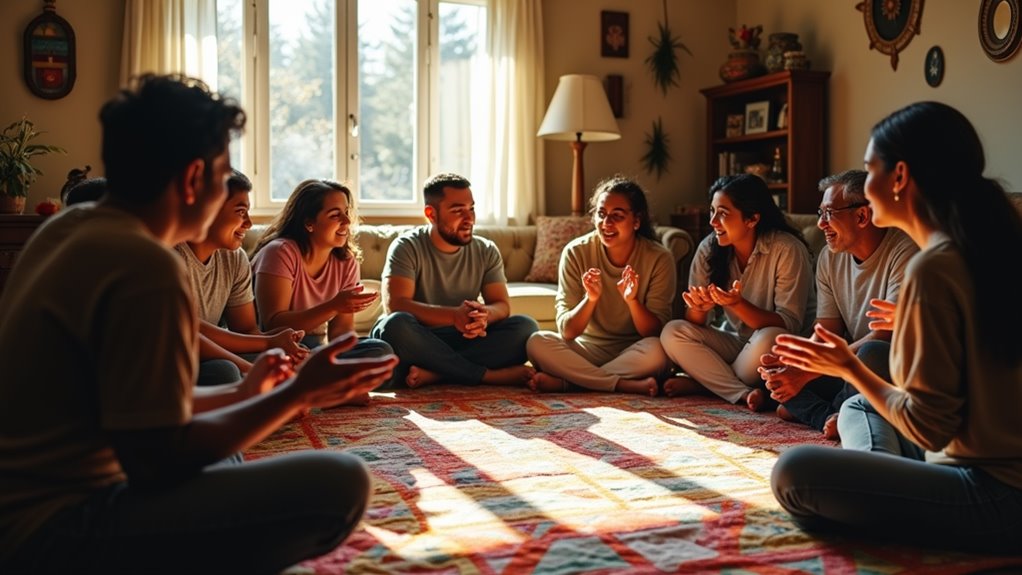Exploring how different cultures handle family conflicts shows you just how important it is to understand each other's backgrounds. For example, some cultures focus on harmony, choosing to avoid direct confrontations, while others express feelings openly. This mix leads to unique strategies, like using storytelling or humor to ease tensions. Also, when family members communicate their expectations and listen actively, it helps everyone feel heard. Plus, elders often step in to guide discussions, reminding everyone of their values. Want to learn more about these fascinating cultural practices? Keep on diving into this topic!
Understanding Cultural Contexts
Understanding cultural contexts is essential when maneuvering family conflict resolution. It's like trying to solve a puzzle—you need to know what pieces fit where. Different cultures have unique ways of handling disagreements, and that can really change the game. For example, in some cultures, people might avoid direct confrontation because they value harmony. Others might see open discussions as a way to solve problems. Knowing these differences helps you understand why your family members might react the way they do.
When you're aware of these cultural backgrounds, you can approach conflicts with more empathy. Instead of jumping to conclusions, you can ask questions and learn what's important to them. This understanding can help you find common ground, which is key in resolving issues. Plus, it can prevent misunderstandings that could lead to bigger fights.
Think of it this way: if you know that your cousin values respect and tradition, you're less likely to accidentally offend them.
Communication Styles Across Cultures
When maneuvering family conflicts, it's crucial to pick up on the different communication styles that various cultures bring to the table. You might notice that some cultures prefer direct communication, where people say exactly what they mean. Imagine being at a family dinner, and someone just says, "I disagree," without any fluff. It can feel invigorating, right?
On the flip side, other cultures lean toward indirect communication. This means they might hint at their feelings instead of stating them outright. So, instead of saying, "I'm upset," they might say, "It's been a long day." This can feel a bit like decoding a secret message!
Some cultures prioritize harmony, so they might avoid confrontation altogether. They believe that keeping the peace is more important than airing grievances. It's like trying to walk on eggshells—you want to express yourself, but you don't want to break anything.
Understanding these styles can help you navigate conflicts better. You'll find that some family members might need gentle nudging to express themselves, while others might appreciate a straightforward chat.
Expectations in Conflict Resolution
Expectations play an essential role in how family conflicts are resolved. When you think about a disagreement, what do you expect to happen? Do you hope everyone will listen and find a solution together? Or maybe you think someone will just storm off? These expectations shape how you act and react during conflicts.
For example, if you expect your family to talk things out, you might feel calm and ready to share your feelings. But if you think things will get heated, you might feel nervous and shut down. It's important to remember that everyone in your family has their own expectations, too. This can lead to misunderstandings, where one person thinks they're being helpful, while another feels ignored.
Setting clear expectations can help. You might say, "I'd like to talk about this calmly," or "Let's take a break if we get too upset." This way, everyone knows what to expect and can work together towards a solution.
And who knows? You might even laugh it off later, realizing that family conflicts can sometimes be a little silly in hindsight! So, keep those expectations in check, and let's resolve those conflicts with a smile!
Strategies for Addressing Disagreements
Maneuvering disagreements in a family can feel overwhelming, but having effective strategies up your sleeve can make all the difference.
First, try to listen actively. This means really paying attention to what others are saying, rather than just waiting for your turn to speak. You might be surprised at how much you can learn from their perspective!
Next, use "I" statements to express your feelings. Instead of saying, "You never listen," try, "I feel unheard when I'm interrupted." This way, you're sharing your feelings without pointing fingers, which can help reduce tension.
Also, take a break if things get too heated. A little time apart can cool down emotions and help everyone think more clearly.
Lastly, don't forget to find common ground. Instead of focusing on the problem, look for solutions you all can agree on. Maybe you'll even crack a joke to lighten the mood!
The Role of Elders and Authority
In many families, elders play an essential role in guiding conflict resolution and maintaining harmony. Imagine you're in a disagreement with a sibling, and suddenly, Grandma walks in. She doesn't just bring cookies; she brings wisdom! Elders often have a special way of seeing things, drawing from their life experiences. They can help settle disputes with a calm voice and a sprinkle of humor.
When tensions rise, you might notice that family members turn to an elder for advice. It's like having a referee in a game—someone who knows the rules and can help everyone play fair. Elders often remind us of the family's values, emphasizing the importance of love and respect. You know, they've been through their share of squabbles too, so they've got a few tricks up their sleeves!
Not only do they provide guidance, but they also encourage open communication. When you listen to their stories, you realize that conflict resolution isn't just about winning; it's about understanding each other.
Case Studies of Cultural Practices
Elders aren't the only ones who shape how families handle conflicts; cultural practices also play a significant role.
Let's take a peek into some fascinating case studies that show how different cultures approach conflict resolution.
In many Native American communities, families often turn to storytelling. Instead of arguing, they share stories that highlight lessons learned from past conflicts. This way, everyone learns together, and it's not just about winning or losing. Sounds pretty wise, right?
Then there's the Japanese practice of "tatemae" and "honne." In this approach, families avoid direct confrontation. Instead, they express their true feelings indirectly, often using subtle hints. While it may seem confusing, it helps keep harmony in the family, like a smooth dance where everyone knows their steps.
Lastly, in some African cultures, families use communal meetings to resolve disputes. Everyone gathers around, and each person shares their thoughts. It's like a family reunion but with a purpose!
These examples show that cultural practices can really shape how families deal with conflicts. They add a unique flavor to the resolution process, reminding us that there's no one-size-fits-all approach!





